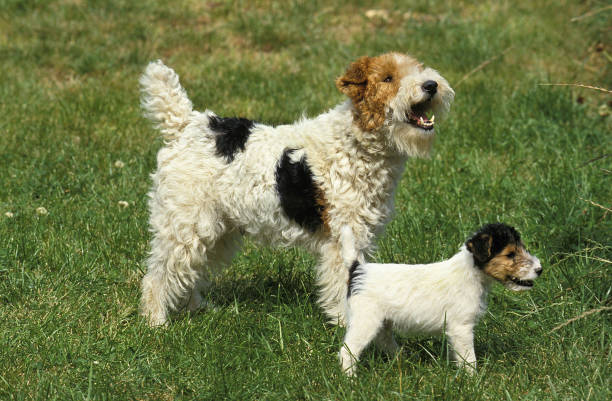Wire Fox Terrier

Breed History:
The Wire Fox Terrier originated in England during the 18th century and was bred to bolt foxes from their dens during traditional fox hunts. Developed primarily from black-and-tan terriers, it shares ancestry with other British working terriers and was favoured for its fearless nature and stamina.
Though similar to the Smooth Fox Terrier, the Wire variant was recognised as a separate breed in the late 19th century. It gained popularity not only in the field but also in show rings and pop culture, notably through “Snowy”, Tintin’s dog. Today, it's prized for its bold personality, intelligence, and energetic temperament.
|
Gender |
Height |
Weight |
|
Male |
38–41 cm |
7–9 kg |
|
Female |
35–39 cm |
6–8 kg |
Size: Small to Medium
Life Expectancy: 12–15 years

Breed Appearance:
The Wire Fox Terrier has a compact, athletic build with a short back and long legs. Its most distinctive feature is its dense, wiry double coat, which forms a beard and bushy eyebrows on the face.
The coat is predominantly white with black or tan markings, and the breed has a long, flat skull, v-shaped folded ears, and a high tail carriage. Its alert expression and upright stance exude confidence and readiness.
Breed Type – Terrier:
A classic earthdog, the Wire Fox Terrier was bred for courage, curiosity, and relentless energy. It’s a true terrier—bold, independent, and always ready for action.
While its hunting days are largely behind it, the breed still has a strong prey drive, making it alert and lively both indoors and out.

Training:
Training a Wire Fox Terrier is both fun and challenging. It is intelligent and quick to learn, but also independent and mischievous. Early socialisation and consistent positive reinforcement are key.
Mental stimulation through games, agility, or puzzle toys helps keep boredom and destructive behaviour at bay. Without firm leadership, they may try to outsmart their owners.
Health & Care:
The Wire Fox Terrier is a robust breed, but some health issues may include:
-
Deafness
-
Legg-Calvé-Perthes disease
-
Cataracts and lens luxation
-
Epilepsy
-
Allergies or skin sensitivities
Regular vet visits and health testing from responsible breeders help mitigate risks. They are generally long-lived with proper care.

Living Conditions:
This breed adapts well to most environments, including apartments, as long as it gets enough physical and mental stimulation. It thrives in active homes and does well with secure outdoor space.
However, due to its high prey drive, it’s best kept in fenced yards and on leash during walks. Caution is advised around small pets and wildlife.
Exercise:
The Wire Fox Terrier is high-energy and needs daily activity to stay happy and manageable. This includes:
-
Walks and jogs
-
Playtime and fetch
-
Agility or obedience training
-
Interactive games and puzzle toys
Without adequate exercise, they may develop boredom-driven behaviour issues such as digging or barking.
Grooming:
Grooming involves more than just brushing:
-
Regular hand-stripping maintains coat texture and colour
-
Brushing several times a week to prevent matting
-
Clean ears and trim nails as needed
-
Routine dental care
For show dogs, professional grooming is essential. Pet Wire Fox Terriers may be clipped for easier upkeep, though this softens the coat.

Advantages:
-
Energetic, lively, and entertaining
-
Intelligent and excels in dog sports
-
Low shedding, hypoallergenic coat
-
Loyal and affectionate with family
-
Long lifespan and robust health
-
Highly alert, makes a good watchdog
Disadvantages:
-
Needs frequent mental and physical stimulation
-
Strong prey drive—not ideal with small pets
-
Can be stubborn and headstrong
-
Requires skilled grooming (hand-stripping)
-
May bark excessively if under-stimulated
-
Can be aggressive toward other dogs if not socialised early

